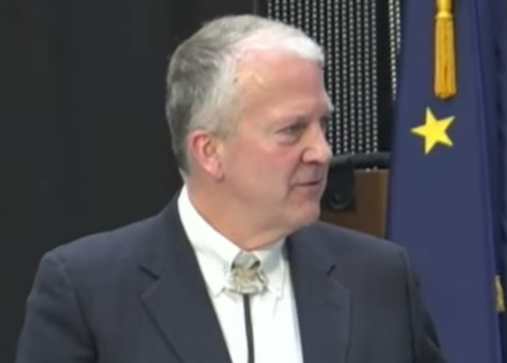
Photo courtesy of N. Ruppert.
Natalia Ruppert was at the dentist when she heard the ping of a text message on her phone. When she rose out of the chair, she noticed a magnitude 4.2 earthquake happened near Noatak. “Aftershock,” she thought, as she remembered her recent visit to the northwest Alaska village of about 500 people.
Ruppert, a seismologist with the Alaska Earthquake Center in Fairbanks, last week flew north at the request of Northwest Arctic Borough Mayor Reggie Joule. She happened to be working on the Saturday he called the Alaska Earthquake Center after a decent shake the night before. Joule was looking for information on recent trembling in an area of Alaska that doesn’t often experience large earthquakes.
Three days after Joule’s call, Ruppert was on a plane to Kotzebue and then Noatak with Earthquake Center technician Christopher Bruton. Ruppert traveled to those towns for her first time ever to answer peoples’ questions. Bruton’s mission was to install seismometers in places featuring both electricity and an Internet connection to get a better idea of what the northwest Alaska earthquakes were like.
Like Ruppert, Bruton had prior experience with spontaneous deployment. In early January 2013, a magnitude 7.5 earthquake tore the sea floor off the coast of Southeast Alaska. Bruton flew to Sitka and found his way down to Port Alexander, a fishing outpost on the south point of Baranof Island. There, he installed a broadband seismometer that remained in place until late last summer, when Port Alexander resident Bill Luedke recovered it for the seismologists and mailed it back to the Geophysical Institute in Fairbanks. Bruton packed the same one for the recent Kotzebue trip.
Ruppert also traveled to Southeast Alaska last winter, performing a similar mission to her recent ones in Kotzebue and Noatak. She gave PowerPoint presentations in Craig, on Prince of Wales Island, and Sitka. Both of her talks attracted dozens of locals who peppered her with questions.
Born and raised in Russia, Ruppert is not the Einstein lookalike people perhaps expect when they hear an earthquake expert is coming to visit. Having observed her as an audience member in Sitka and Craig, I can report that her pleasant accent and sure manner have a calming effect on those who are worried about big shakes (and in the case of Southeast Alaska, the waves that might follow).
Last week, Ruppert spoke on the radio in Kotzebue and gave five presentations in Noatak, which was within about 20 miles of the epicenter of a 5.6 earthquake on April 18 and a sizable 5.5 aftershock May 3.
In one day, she spoke to three classes of school children, gave a presentation to the tribal council, and spoke to those assembled in the Noatak school gym at night. She told people that though northwest Alaska does not shake as frequently as Southeast Alaska or the Aleutians, “normal” earthquakes produced when built-up stress is released from hidden faults sometimes happen in the Noatak area.
Trained in earth science and physics, Ruppert is getting more comfortable with public speaking, which is perhaps a natural by-product of knowing what you are talking about. She thinks squashing rumors is the most valuable part of her occasional journeys to remote Alaska.
No, she told people, thawing permafrost did not cause the Noatak earthquakes. Frozen ground is relatively close to the surface and these earthquakes rumbled five-to-15 miles deep. For the same reason, activities at nearby Red Dog Mine did not cause the earthquakes. Lastly, a big earthquake in Thailand did not trigger the recent shakes in northwest Alaska. Far-off earthquakes can shake faults into action far away, but the timing is almost immediate as waves travel through the earth like ripples in a pond.
Even areas of Alaska not sitting on obvious fault lines are subject to earthquakes, Ruppert said. The only real aseismic part of Alaska seems to be the tundra north of the Brooks Range. Seismologists know very little about northwest Alaska because there are few instruments there and researchers haven’t studied the area much.
“Though it’s rare, it’s not unprecedented,” Ruppert said, citing a 5.5 earthquake near Noatak in 1981. “An important message is that there will still be aftershocks for a few weeks.”



